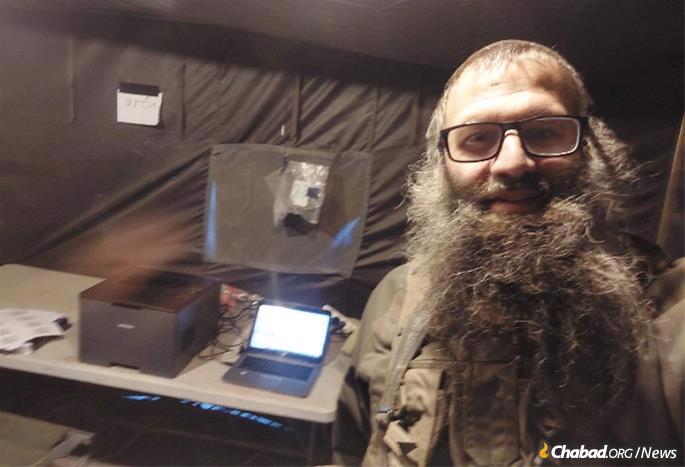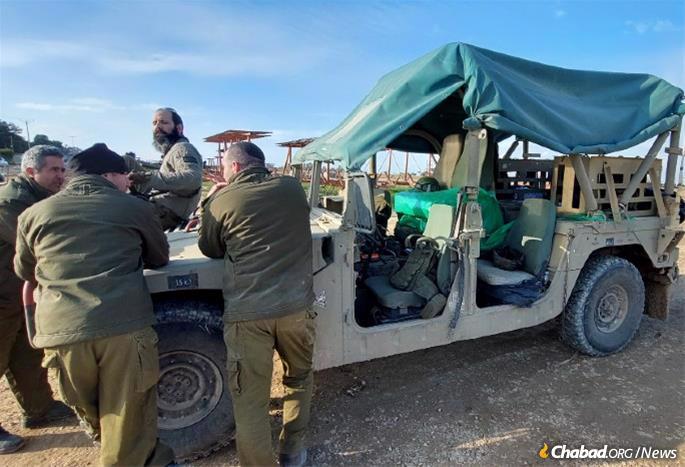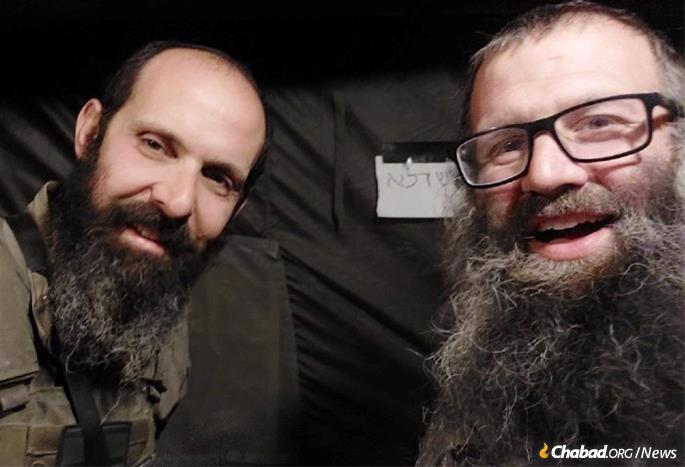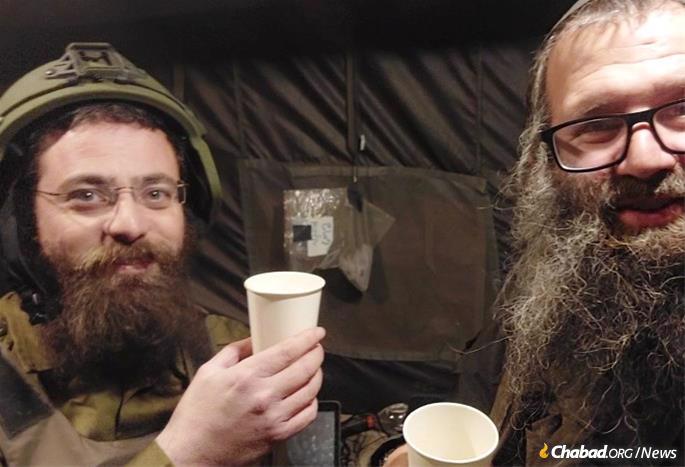
After Months of Starts and Stops, the Tanya is Printed in Gaza
by Yaakov Ort – chabad.org
While a hard, cold rain was falling on Gaza at 6 a.m. on Wednesday, Jan. 24, Israel Defense Forces Maj. Ezzy Morgenstern got a text message at his home in Yavniel, in Israel’s north: “Get everything ready. You’re going in today.” After months of frustrating starts and stops, Morgenstern—a Chabad rabbi, IDF chaplain and combat engineer with the Golani brigade—rushed to kibbutz Ein Hashalosha in the western Negev to pick up a portable book-printer and then sped to the Gaza border. There, he joined an armed convoy and headed into the heart of the war zone in Gaza, where he printed 100 copies of the Tanya, the seminal work of Chassidic thought written by the founder of Chabad, Rabbi Shneur Zalman of Liadi.
From the first day that IDF troops entered Gaza on Oct. 13, Morgenstern considered it a personal mission to print the Tanya in Gaza. During the 1982 Lebanon War, the Rebbe, Rabbi Menachem M. Schneerson, of righteous memory, directed a group of Chassidim to print the Tanya in various Lebanese cities, including the capital city of Beirut. Among the Rebbe’s instructions were to distribute pages of the Tanya to Jews wherever it was printed, even before it was bound; to print the name of the city where it was printed in both Hebrew and Arabic; and to stay out of danger. Morgenstern knew he must do the same.
From the start of the war, with the help of Rabbi Menachem Offen—the Chabad Youth Organization of Israel’s official liaison to the IDF—Morgenstern spoke to top generals in the Golani battalion who gave the OK to print the Tanya in Gaza five times, but every time something prevented it from happening.
After months of frustration, Morgenstern’s unit is being transferred from Gaza to the Lebanon border, where he will be on active duty, and this was the last week that he could print the Tanya in Gaza. The rabbi’s wife, Michal, noted that a family friend, Yaakov Kruliak, a Chabad Chassid serving in Gaza with the mechanized transport division, might be able to help.
Krugliak said that he would do his best to make it happen, but only trained combat soldiers like Morgenstern would be permitted to enter. Once he got the early-morning text message from Krugliak, the rabbi sped to Ein Hashalosha.

A Crash Course in Printing
Azar ben Ephraim, the printer who is responsible for printing all Tanyas in Israel, was waiting for Morgenstern. Initially, ben Ephraim was going to provide a large printer and generator, but they were too big to be taken into Gaza by this convoy, so Morgenstern had to make do with a small portable printer.
Ben Ephraim’s son, a combat soldier in Khan Yunis, knows how to operate the printer and laptop running the software, but he had no way of reaching him. None of ben Ephraim’s staff are combat soldiers, so it was up to Morgenstern to learn how to become a printer in about an hour. “Being an engineer helps,” says the rabbi, who packed up the printer, a laptop, cartridges of ink and 3,000 sheets of paper and sped off to Gaza.
After hours of delay at the border with massive explosions going off in the background, Morgenstern and the printer entered Gaza in a jeep along with tanks and armored personnel carriers. He was directed to a special project tent that is almost always in use by officers but happened to be empty that day. He zipped up the tent and got to work.
“Officers kept asking me how long it would take, and I told them an hour and half tops, but with paper jams, cartridge changes and frequent blackouts that caused the printer and software to reset, the printing took more than five hours.”

Meanwhile, Offen, himself a combat veteran, was able to enter Gaza after a number of hours at the border and join Morgenstern in the tent at about 4 p.m. While Morgenstern was printing pages, Offen was keeping busy putting on tefillin with troops and putting up mezuzahs in operations rooms at the entrance to the compound.
As pages came off the printer, Offen and the troops sang Chabad melodies associated with the seven Rebbes of Chabad-Lubavitch, and then learned chapter 32 of Tanya—the chapter known as “the heart of Tanya—with pages hot off the press.

Remembering the Rebbe’s Response
The rabbis were able to catch a convoy out of Gaza at 9 p.m. As they left, they reflected on the Rebbe’s response to the printing of the Tanya in Lebanon in 1982.
The Rebbe had specifically instructed that the Tanya should be printed in Beirut, the capital of Lebanon. As soon as the books were printed, a few copies were rushed out of Lebanon to Ben Gurion airport where a traveler brought them to New York. He was met at the airport by Chassidim who delivered the copies to Rabbi Yehuda Krinsky, who was with the Rebbe at the Ohel, the resting place of the Sixth Rebbe.
In a farbrengen held that week, the Rebbe said that “When they display their physical weaponry it casts fear upon the enemy. This is especially so when it comes alongside our true ammunition, when we ‘call upon the name of the Lord our G‑d’ and then proceed to ‘assemble our troops in his name’.”
“Since people like things to be exciting,” the Rebbe continued, “here is proof that the Israelis have entered Beirut itself. Here is a Tanya that was printed in Beirut. They even had ample time to bring it here. When they printed it, they held a farbrengen with the soldiers, they drank l’chaim, for the good of the soldiers, and the entire Jewish people.
“This all took place a few days ago, since it obviously took time for the Tanya to arrive so it could be here on the table today. And inside this Tanya, it says that it was printed in Beirut!”
Morgenstern says the experience of printing a Tanya in Gaza 42 years later was among the most meaningful of his life, a joy that was heightened by all the delays and frustrations. He says that the Chabad Youth Organization will buy the small printer he used to print the Tanyas in Gaza so it will be immediately available for other IDF chaplains to print wherever and whenever needed.
“With G‑d’s help, we’re going to be printing Tanyas in many more interesting places,” said Morgenstern.














